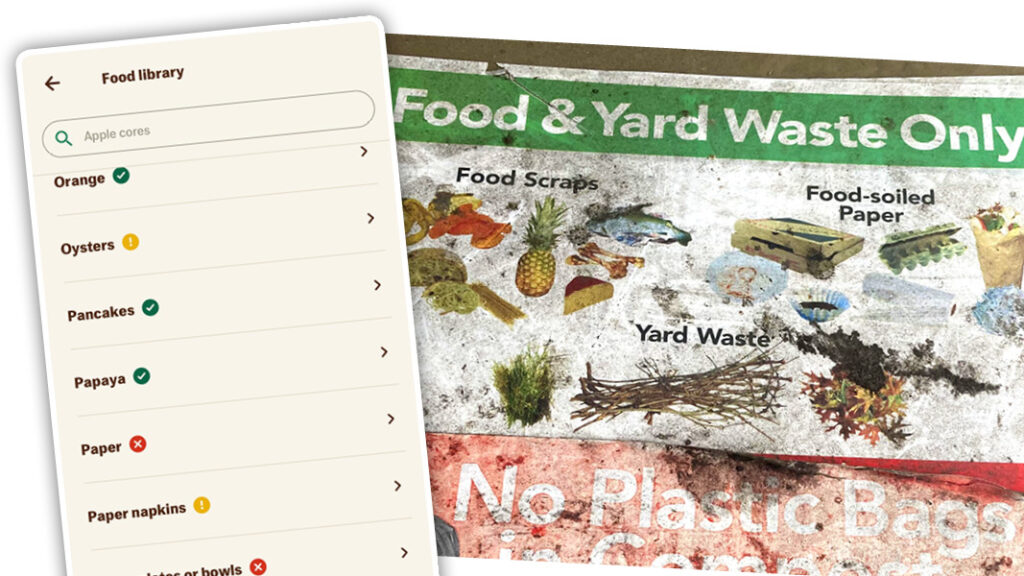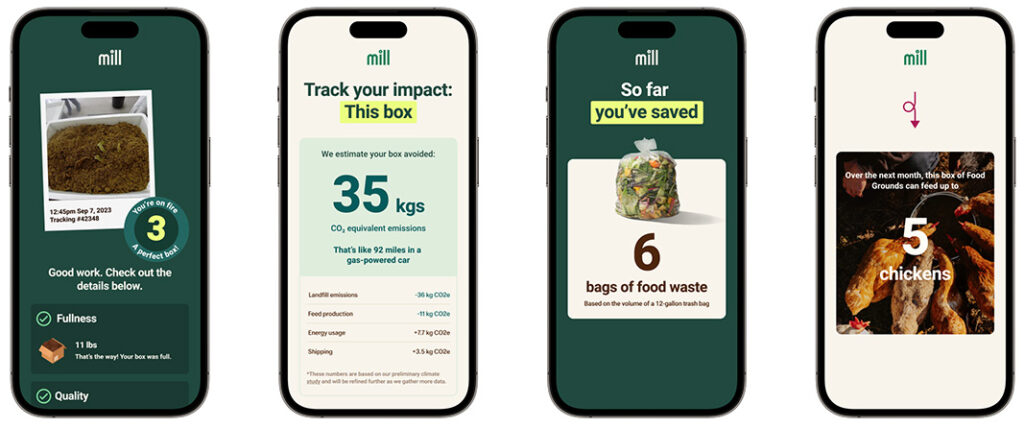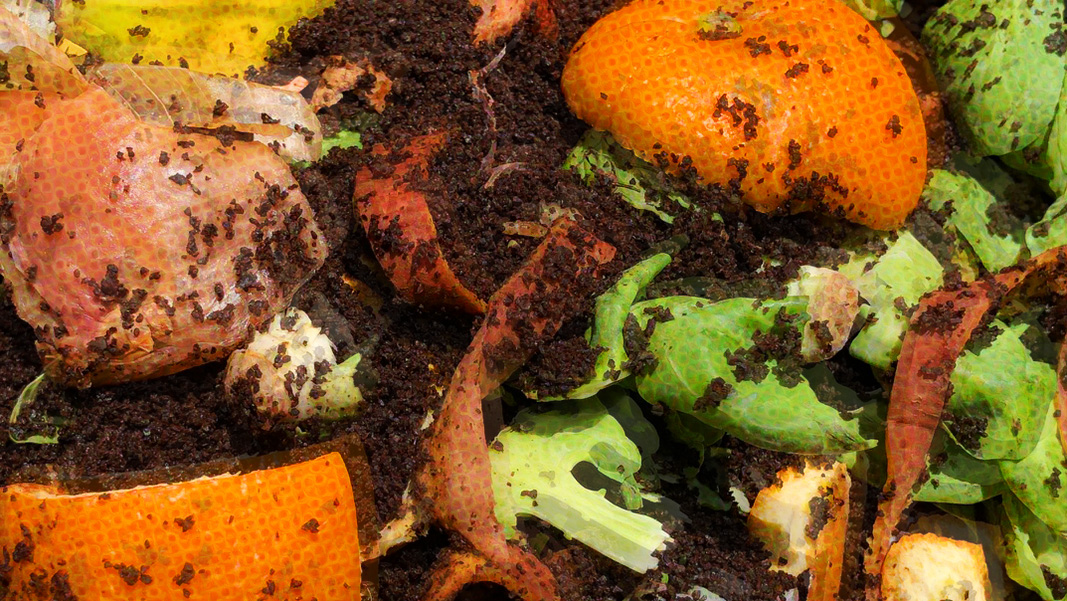Top: Photo by Nora Goldstein
 Sally Brown
Sally Brown
Old habits die hard. Change can be a very scary thing. Even when it centers on something as mundane as how you take out the garbage. Food scraps diversion from landfills is quickly becoming the norm in several states across the country. Taking food scraps out of landfills yields major reductions in methane. That gives us a quick and easy way to reduce carbon dioxide (CO2). Turning them into compost gives us healthy soils and conserves nutrients. Putting them in an anaerobic digester first gives us green energy. There is no downside to this, just a potential for slime and odor.
The problem is saying that and actually having it become the reality are two very different things. Scientific fact and your garbage don’t always see eye to eye. If you want proof of that just look at my column from a few weeks ago that showed how low diversion rates are in Seattle, the home of environmental awareness. Accomplishing broad scale diversion and the associated production of high quality compost is a huge mountain to climb. Even though we are much closer to climbing than we’ve ever been doesn’t guarantee that we’ll make it to the top. What is the best path to get to the summit?
There is a whole science associated with behavior change. Just because something is the right/best thing to do doesn’t mean that people will be willing to do it. How a new idea or behavior comes to be accepted is referred to as diffusion. As the term suggests, the new behavior has to gradually diffuse through society until it becomes normal. This is the same basic idea as painting with watercolors. The color gradually diffuses through the water until the entire area turns. An idea starts with a kernel of people and gradually, through different channels becomes broadly known and accepted. As far back as 1943, Ryan and Gross recognized five stages in the diffusion process: Knowledge of an innovation; forming an attitude toward the innovation; a decision to adopt or reject; implementation of the idea; and confirmation of the decision (Ryan and Gross, 1943).
Not everyone is ready to accept change with open arms. Diffusion research has split people into groups based on how readily they accept and adopt new behavior. These are referred to as Adopter categories (Rogers, 1958, Ryan and Gross 1943). First on the bandwagon are innovators, followed by early adopters, early majority, late majority, and laggards (Rogers 1961). Change becomes fully integrated only after you make it your own (Eveland et al, 1977). Re-invention is the term used to describe the degree to which an innovation is modified by a user in the process of its adoption and implementation. You might think of bedazzling your food scraps. Discontinuance is a decision to reject an innovation after having previously adopted it.
Motivation To Source Separate
An example of this is biosolids use by farmers in the Pacific Northwest. The King County (Washington) biosolids program designers must have read up on the science of behavior change when they started moving towards a beneficial use program. Using biosolids for dryland wheat cultivation was seen as a potentially excellent option. There are many acres dedicated to growing wheat in eastern Washington, an area of low population and low precipitation. The biosolids program reached out to three farmers in the area who were well known and respected, hoping that they would be innovators for the practice. Since that time, using biosolids in eastern Washington’s Douglas County has become a pretty standard practice with over 130 farmers signed up and a waiting list for farmers to get their cake.
A big difference here between using biosolids and separating food scraps is the clear benefit to those who adopt the new practice. By using biosolids the farmers save on fertilizer costs and typically get higher yields. In other words, they make more money. But what does the general public get by diverting food scraps? The knowledge of avoided methane (CH4) emissions is likely not sufficient to motivate people. There needs to be sufficient motivation to make this new behavior stick. Altruism is likely not sufficient.
South Korea is the one nation that has done the best in getting people to change their disposal ways. This was done by making food scraps diversion mandatory and also making mandatory how food waste was to be separated. Residents are required to use special bags to separate food scraps that are then collected six days a week. The bags cost money, albeit not very much. In some cases, residents can pay to access automated collection units where they can directly dump their food scraps (Kim, 2022; Yoon, 2023). Spreading the cost and making separation accessible and convenient are seen as key to the success in South Korea.
Where Are The Benefits?
How is it working in the U.S.? In Seattle we get green bins. These are for food and yard waste. They are collected once a week, year-round. The bins have pictures on them showing what is OK to put in. You can also watch a video. But the bins are not in your kitchen. The flyer that was mailed out a decade ago is also most likely not in your kitchen. I have no recollection of what might have happened to mine. The video says that it is OK to use compostable plastic or newspaper (it is an old video) or paper bags to transport your food waste to the green bin. I dare you to use a paper bag with wet food scraps and not experience leakage or breakage. No one wants rotten food spilling all over their house and clothes. I would not give this portion of the program an A+.
However, Seattle has gotten it right in terms of the cost incentive. It costs less to put food and yard waste in the green bin in Seattle than it does to put it into the garbage. A 32-gallon black garbage cart will run you $42.80/month. A 96-gallon green bin will run you only $13.60/month. The Seattle program gets excellent marks for cost structure, but I’m tempted to rate it below the high potential for success curve for ease of use.
The new home food dehydrators are one way to make using paper bags for food scraps a safe and stress-free practice. Once the stuff is dried and ground the fear of bag failure becomes a distant memory. I spoke to folks at Mill about how behavior change was considered in the design of its kitchen unit. Many of the people there came from Nest where the new thermostat was designed specifically to look and work like the older versions to make it accessible. That, plus the fact that the Nest saves you money on your energy bill has made it very successful. Utilities like it too because it can cut demand during peak hours. This success works both for the homeowner and the power provider.

Left: Mill’s food library for acceptable food waste items. Right: Accepted items on Seattle food waste collection bin
The Mill bin was designed to look just enough like a home garbage bin to make it familiar and comfortable. Ease of use and appearance were very deliberately incorporated into the design. The Mill folks are also well aware of the diffusion of knowledge paradigm. Innovators in this day and age are now known as influencers. Mill has deliberately provided units to targeted influencers as a way to spread the word and the behavior change. So, the company has the design down and the influencers down.
The one thing lacking is the benefit component. Each of these units (e.g., Mill, Lomi, FoodCycler) costs you money. None offers you benefits aside from the knowledge that you are doing the right thing (assuming the dried food ends up in a compost pile, a chicken coop or an anaerobic digester). And did I mention that they all cost you money? What hasn’t happened, at least to my knowledge, is for the solid waste people to partner with the home appliance people. For me, this is the necessary step to give food scrap diversion a realistic potential for success. Otherwise, I see the dehydrators as an appliance that stays with the innovators and never makes it to the early majority — not to mention the laggards.

A phone app tracks Mill subscribers’ food scraps diversion and calculates net reduction in carbon dioxide emissions.
In both articles I read about the South Korean success story, the combination of policy, home convenience and an appropriate cost structure are recognized as must haves. These home dehydrators are miles ahead of paper bags. The phone apps associated with them (here I am speaking for Mill) offer convenience and clarity in your kitchen versus the guidance on the green bin. It would seem that rather than attempting to reinvent the bin, the cities and states that have passed regulations on food scraps diversion should make friends with some of these new devices. Working together, there is a chance that this massive overhaul of how we throw out garbage can experience the change that we need. Behavior change is tough. This is a way to give it a chance.
Sally Brown, BioCycle Senior Adviser, is a Research Professor at the University of Washington in the College of the Environment. Dr. Brown acknowledges Kristen McIver with Harvest Pierce County (WA) whose PhD dissertation includes information on diffusion that is used in this column.













